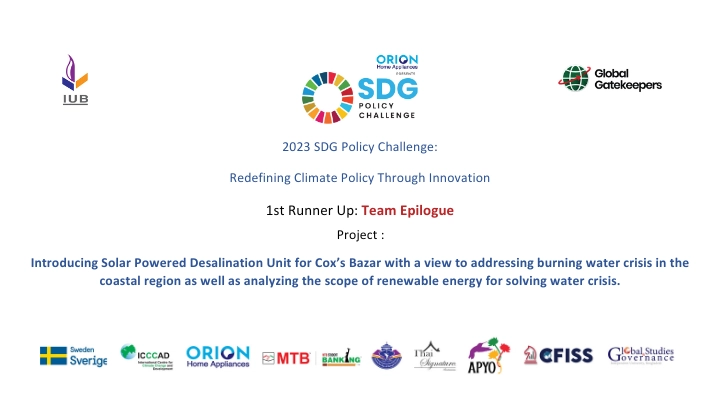Introducing Solar Powered Desalination Unit for Cox’s Bazar with a view to addressing burning water crisis in the coastal region as well as analyzing the scope of renewable energy for solving water crisis.
Masrhid Monir Khan,Jafrin Rahman Nahin, IUT || Shining BD
Introduction:
Bangladesh, a deltaic country with low lying areas that is tucked between India and Myanmar, is struggling with an increasingly severe water crisis that is being made worse by saline intrusion and the extensive effects of climate change. Bangladesh's landscape is defined by a complex web of rivers and estuaries that provide both sustenance and vulnerability, making the nation especially vulnerable to the negative effects of rising sea levels and shifting climatic patterns.
Salinity intrusion is one of the main causes of Bangladesh's water crisis. This incursion is mostly seen along the coast, where the delicate equilibrium between freshwater and saltwater is increasing. Sea levels rise as a result of polar ice caps melting due to an increase in global temperatures. As a result of the increased sea levels, saltwater is more likely to seep into groundwater and river deltas, contaminating vital freshwater resources.
The consequences of salinity intrusion are dire and multifaceted. Agricultural lands, which form the backbone of Bangladesh's economy, are adversely affected as saline water infiltrates the soil. Furthermore, Salinity intrusion also has a significant impact on the population's overall health and well-being. The public's health is seriously threatened by contaminated water sources, which raise the risk of waterborne illnesses. Getting access to clean, drinkable water becomes a daily struggle, especially for people living in coastal communities. Climate change acts as a compounding factor, intensifying the impacts of salinity intrusion. Erratic weather patterns, extreme events such as cyclones and storm surges, and altered precipitation trends further challenge the resilience of communities already grappling with the encroachment of saltwater.
2. Proposed Idea:
The proposed idea is “Solar powered desalination unit”.
Such desalination plant in Bangladesh offers a sustainable solution to the country and its pressing water and energy challenges. This innovative system uses the abundant sunlight and clean energy to convert saline water into drinkable fresh water. This will significantly reduce dependence on fossil fuels, limit carbon dioxide emissions and promote climate change resilience. Effective both on the coast and inland, this system is a combination of renewable energy and public health safety. This groundbreaking project demonstrates Bangladesh's commitment to sustainability, energy security and climate change mitigation.
3. Problem statement:
Bangladesh is a low-lying country with 19 coastal districts and a combined of 42 million of populations living in this region. Salinity intrusion has become one of the biggest crisis within these regions. From 83.3 million hectares of land in 1973 to 106 million hectares of land in 2009, salinity has increased around 26% in Bangladesh in the last 35 years, spreading into non-coastal areas (example: Jessore) as well.
Key problems identified due to groundwater salinity are given below:
- Increasing soil and water salinity
- Reduced agricultural productivity resulting in less crops production.
- Contaminated drinking water because of saltwater invasion.
- Loss of livelihoods and biodiversity for coastal community
- Impact on aquatic ecosystems and fishermen livelihood
- Difficulty in obtaining fresh water for irrigation and domestic use.
- Lack of food security and economic stability.
- Challenges in providing adequate infrastructure for salinity-affect areas
4. Policy Statement:
4.1 Target region: Cox’s bazar
Figure: 3 target impact demography of the project
Target impact demography: Primarily tourists and local inhabitants in Cox’s Bazar. Secondary target demography is 1 million Rohingya refugees who are currently living in Cox’s Bazar's 36 different locations and also facing an acute crisis of safe drinking water.
4.2 Current condition of the target area and demography:
The severe lack of drinking water in Cox's Bazar has caused a lot of suffering for the local population as well as the millions of tourists visiting the place every year. Every year, the level of the groundwater is decreasing by 10 to 15 feet. In a number of unions across nine upazilas, including Cox's Bazar town, the water level is declining. The surroundings of Cox's Bazar city, as well as Ukhia, Teknaf, and Chakaria, are particularly bad. Approximately 7000 of the district's 31000 tube wells are no longer functional. At least a few thousand tube wells are without water. Additionally, this crisis is more alarming in Ukhia-Teknaf's 34 Rohingya refugee camps.
4.3 Applicability & inapplicability
Applicability:
- Cox's Bazar, like the majority of Bangladesh, has solar resources and sunlight available throughout the year. Average temperature of the region ranges from 26 degree Celsius to 32 degree Celsius.
- Renewable Energy Potential: Bangladesh Government has proclaimed a vision of generating 40% of it’s total power supply from renewable sources within 2041. The country also has potential to raise a funding of $38.44 billion in various international sources. Therefore, it is relevant to say that solar desalination aligns with national and global efforts to increase renewable energy capacity
- Modularity and Scalability: Solar desalination systems can be easily installed in modular units, making them suitable for both small-scale community use and larger installations
- Minimal Operating Costs: Solar power is generally cost-effective for operating desalination systems. Once installed, solar panels require minimal maintenance, making it an economically viable solution.
Inapplicability:
Intermittency and Environment consideration: Even though Cox's Bazar receives a lot of sunlight, solar energy production is still sporadic because of environmental factors like cloud cover and monsoons. Being a prime coastal city, the region often undergoes sudden natural calamities in rainy seasons. Battery-based energy storage systems may be necessary to during the time of calamity, which can increase the cost.
- Landscape and scope of renewable energy sources as a potential solution:
In order to meet the rising energy needs and lessen the reliance on fossil fuels and natural gas, Bangladesh has been actively pursuing renewable energy options. To date, total installed capacity of renewable power in Bangladesh stands at around 631 MW comprising less than 3% share of total electricity generation, which falls far short of its target of 2000 MW.
Bangladesh that is heavily dependent on foreign import of fossil fuels to meet internal energy demand. Therefore, factors like war (Russia-Ukraine) may play as a big influence in our energy market.
- Why Solar energy:
In total share of 3% to the national energy consumption, hydro, solar and wind energy share 60%, 39.5%, and 0.5% per cent respectively making solar energy the fastest growing renewable energy sector in Bangladesh. Solar energy is considered as the most feasible choice because most Bangladeshi districts get an average of 4-5 peak sunlight hours per day throughout the year, making it one of the sunniest countries in the world.
6. Design & implementation of the suggested proposal:
6.1 Solar panel installation and distribution flow diagram:
6.2 Solar panels provide power implications for the following requirements:
- High Pressure Requirement: In order to push the water molecules through the RO membranes, seawater is subjected to pressures higher than the natural osmotic pressure.
- Hydraulic Energy Generation: The hydraulic energy required to push the seawater through the membrane and overcome the osmotic pressure is supplied by these pumps.
- Energy Intensity: The RO membranes have a high energy intensity, and in order t physically separate water molecules from salt ions and other impurities, a significant amount of electrical power is used.
- Pressure Maintenance: To maintain the pressure as water moves through the various stages of the RO process, pressure maintenance pumps may be required.
6.3 Desalination process (Reverse Osmosis)
- RO pump: With high pressure, it will transfer sea water to storage
- Feed pump- will transfer the water from feed tank to sand filter
- Sand filter with a pressure gauge -The process occurs in such a way that water goes in and the opening is in the bottom of the tank. The water travels in an upward direction through the sand and goes to the carbon filter. In this way the whole particle is separated from the sea water.
- Carbon Filter with a pressure gauge - In the carbon filter odor and color from the water is removed.
- Water softener with a pressure gauge - It contains 9 resins which separate other impurities.
- Filter (PPC) & Pressure Switch - It presses the water to raise to a certain level so that it can travel to the membrane.
- Membrane Filter- It removes all the dissolved substance and makes it drinkable.
- Waste Water Outlet - Waste water (concentrated brine) outlet leads the waste to another way through the flow meter.
- Storage Tank - Through mineral water outlet treated water goes to storage tank.
6.4 Harmful byproduct:
This process leaves behind a large amount of highly concentrated brine as a waste product, which is often disposed of by returning it to the sea which hamper marine ecosystem.
6.5 Mitigation of negative impact:
The waste brine can be used to produce sodium hydroxide, among other products. Otherwise known as caustic soda, sodium hydroxide can be used to pretreat seawater going into the desalination plant. This changes the acidity of the water, which helps to prevent fouling of the membranes used to filter out the salty water.
Brine Solution NaCl + H2O
Electrolysis:
NaCl Na+ + Cl-
H2O H+ + OH-
At Cathode, 2H+ + 2e- H2
At Anode, 2Cl- Cl2 + 2e-
NaOH Na+ + OH-
7. Impact area:
7.1 Targeted 3 P’s of the project:
- People: With a 2,289,990 population, 1 crore tourists visited every year and an additional 1,000,000 plus refugees living in this area, “People’s Betterment” is the first impact sector of the suggested idea. Installing a solar energy based desalination unit has the capacity to turn the abundant seawater of the region into clean drinking water and thus impacting the lives of at least 1 million people.
- Planet: By combining solar energy with a desalination unit, we can demonstrate the feasibility of using renewable energy sources into critical infrastructure. A solar powered desalination unit utilizes clean energy from the sun, producing zero greenhouse gas emissions during the desalination process.
- Profit: This process is indeed a profitable business which generates approximately 20,00,00,000 profit within 15 years and touches breakeven point in first 11 years.
8. Distribution
9. Financials:
9.1 Initial Cost Assumption
9.2 Potential Investors
10. Conclusion:
In response to water crisis in coastal region, Bangladesh has initiated various adaptation strategies, including the construction of embankments, saline-tolerant crop varieties, and improved water management practices. International collaborations and assistance are also crucial in developing sustainable solutions to mitigate the effects of the water crisis in Bangladesh. In conclusion, the implementation of a solar-powered desalination unit in Bangladesh epitomizes an eco-friendly and innovative approach to overcome water scarcity, promote renewable energy, and enhance climate resilience.
Reference: (Exempt from the word count)
- Monirul Qader Mirza, M., & Sarker, M. H. (2005). Effects on water salinity in Bangladesh. The Ganges water diversion: Environmental effects and implications, 81-102.
- Islam, M. T., Shahir, S. A., Uddin, T. I., & Saifullah, A. Z. A. (2014). Current energy scenario and future prospect of renewable energy in Bangladesh. Renewable and Sustainable Energy Reviews, 39, 1074-1088.
- Masud, M. H., Nuruzzaman, M., Ahamed, R., Ananno, A. A., & Tomal, A. A. (2020). Renewable energy in Bangladesh: current situation and future prospect. International Journal of Sustainable Energy, 39(2), 132-175.
- Al-Mutaz, I. S., & Al-Ahmed, M. I. (1989). Evaluation of solar powered desalination processes. Desalination, 73, 181-190.
- AlMadani, H. M. N. (2003). Water desalination by solar powered electrodialysis process. Renewable Energy, 28(12), 1915-1924.
- Fiorenza, G., Sharma, V. K., & Braccio, G. (2003). Techno-economic evaluation of a solar powered water desalination plant. Energy conversion and management, 44(14), 2217-2240.
- Panagopoulos, A., Haralambous, K. J., & Loizidou, M. (2019). Desalination brine disposal methods and treatment technologies-A review. Science of the Total Environment, 693, 133545.
- Morillo, J., Usero, J., Rosado, D., El Bakouri, H., Riaza, A., & Bernaola, F. J. (2014). Comparative study of brine management technologies for desalination plants. Desalination, 336, 32-49.
Shining BD























